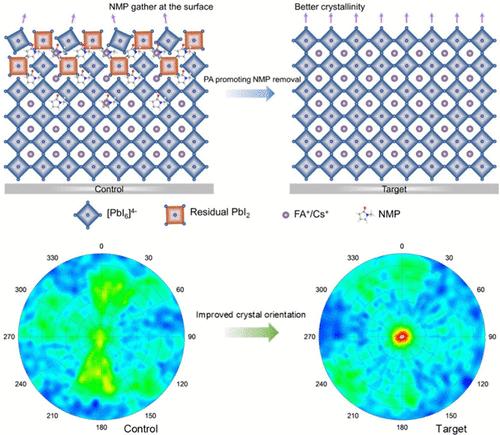残余溶剂管理实现高效无溶剂钙钛矿太阳能电池
IF 18.2
1区 材料科学
Q1 CHEMISTRY, PHYSICAL
引用次数: 0
摘要
在通过无溶剂的方法形成钙钛矿薄膜的过程中,溶剂倾向于锁定在钙钛矿层内部,这种方法通常用于可扩展的大面积制造工艺。在钙钛矿薄膜中残留的n -甲基-2-吡咯烷酮(NMP)阻碍了钙钛矿组分之间的完全反应,对钙钛矿晶体结晶度、晶体取向和稳定性产生不利影响。为了解决这个问题,我们将丙酸(PA)引入钙钛矿溶液中,以促进NMP的去除。PA削弱了PbI2与NMP的分子间相互作用,增加了钙钛矿溶剂体系的挥发性,从而促进了钙钛矿膜形成过程中NMP更有效的蒸发。结果表明,优化后的钙钛矿薄膜晶体质量显著提高,器件在小面积器件中获得了25.86%的冠军功率转换效率(PCE)。此外,通过扩大钙钛矿薄膜面积,刚性组件(4平方厘米)的PCE达到23.08%,柔性组件(超过100平方厘米)的PCE达到16.27%,表明它们非常适合钙钛矿光伏的商业制造。本文章由计算机程序翻译,如有差异,请以英文原文为准。

Residual Solvent Management Enables High-Efficiency Antisolvent-Free Perovskite Solar Cells
During the formation of the perovskite films via the antisolvent-free method, commonly employed in scalable large-area fabrication processes, the solvent tends to lock inside the perovskite layer. The residual N-methyl-2-pyrrolidone (NMP) in the perovskite films hinders the complete reaction between perovskite components, adversely affecting the perovskite crystal crystallinity, crystal orientation, and stability. To address this issue, we introduced propionic acid (PA) into the perovskite solution to facilitate the removal of the NMP. PA weakened the intermolecular interaction between PbI2 with NMP, increased the volatility of the perovskite solvent system, and thus promoted more efficient NMP evaporation during the perovskite film formation. As a result, the optimized perovskite films exhibit significantly improved crystal quality, and the devices exhibit a champion power conversion efficiency (PCE) of 25.86% in the small-area device. In addition, by enlarging the perovskite film area, we achieved 23.08% PCE for the rigid module (4 cm2) and 16.27% PCE for the flexible module (over 100 cm2), showing them to be well-suited for the commercial manufacturing of perovskite photovoltaics.
求助全文
通过发布文献求助,成功后即可免费获取论文全文。
去求助
来源期刊

ACS Energy Letters
Energy-Renewable Energy, Sustainability and the Environment
CiteScore
31.20
自引率
5.00%
发文量
469
审稿时长
1 months
期刊介绍:
ACS Energy Letters is a monthly journal that publishes papers reporting new scientific advances in energy research. The journal focuses on topics that are of interest to scientists working in the fundamental and applied sciences. Rapid publication is a central criterion for acceptance, and the journal is known for its quick publication times, with an average of 4-6 weeks from submission to web publication in As Soon As Publishable format.
ACS Energy Letters is ranked as the number one journal in the Web of Science Electrochemistry category. It also ranks within the top 10 journals for Physical Chemistry, Energy & Fuels, and Nanoscience & Nanotechnology.
The journal offers several types of articles, including Letters, Energy Express, Perspectives, Reviews, Editorials, Viewpoints and Energy Focus. Additionally, authors have the option to submit videos that summarize or support the information presented in a Perspective or Review article, which can be highlighted on the journal's website. ACS Energy Letters is abstracted and indexed in Chemical Abstracts Service/SciFinder, EBSCO-summon, PubMed, Web of Science, Scopus and Portico.
 求助内容:
求助内容: 应助结果提醒方式:
应助结果提醒方式:


